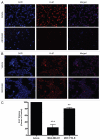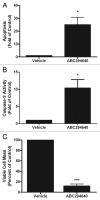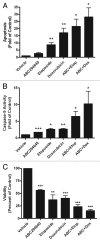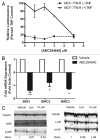Targeting NFĸB mediated breast cancer chemoresistance through selective inhibition of sphingosine kinase-2
- PMID: 21307639
- PMCID: PMC3084971
- DOI: 10.4161/cbt.11.7.14903
Targeting NFĸB mediated breast cancer chemoresistance through selective inhibition of sphingosine kinase-2
Abstract
Resistance to chemotherapy remains a significant obstacle in the treatment of hormone- independent breast cancer. Recent evidence suggests that altered sphingolipid signaling through increased sphingosine kinase activity may be an important mediator of breast cancer drug resistance. Sphingosine kinase-1 (Sphk1) is a proposed key regulator of breast cancer tumorigenesis, proliferation and resistance. There is, however, conflicting data on the role of sphingosine kinase-2 (Sphk2) in cancer biology and resistance, with some suggesting that Sphk2 has an opposing role to that of Sphk1. Here, we studied the effects of the novel selective Sphk2 inhibitor, ABC294640 (3-(4-chlorophenyl)-adamantane-1-carboxylic acid (pyridin-4-ylmethyl) amide), on human breast cancer. ABC294640 blocked both viability and survival at low micromolar IC(50) concentrations in the endocrine therapy-resistant MDA-MB-231 and chemoresistant MCF-7TN-R cell systems. Treatment with the inhibitor significantly reduced proliferation, as seen in immunofluorescence staining of Ki-67 in vitro. Interestingly, pharmacological inhibition of Sphk2 induced apoptosis through the intrinsic programmed cell death pathway. Furthermore, ABC294640 also diminished NF-ĸB survival signaling, through decreased activation of the Ser536 phosphorylation site on the p65 subunit. Xenografts of MCF-7TN-R cells growing in immunocompromised mice were utilized to validate the therapeutic efficacy of the sphingosine kinase-2 inhibitor. Treatment with 50 mg of ABC294640/kg completely blocked tumor volume in this model. These results indicate that pharmacological inhibition of Sphk2 with the orally bioavailable selective inhibitor, ABC294640, has therapeutic potential in the treatment of chemo- and endocrine therapy- resistant breast cancer.
Figures






Similar articles
-
ABC294640, a sphingosine kinase 2 inhibitor, enhances the antitumor effects of TRAIL in non-small cell lung cancer.Cancer Biol Ther. 2015;16(8):1194-204. doi: 10.1080/15384047.2015.1056944. Cancer Biol Ther. 2015. PMID: 26054751 Free PMC article.
-
Sphingosine kinase isoforms as a therapeutic target in endocrine therapy resistant luminal and basal-A breast cancer.Exp Biol Med (Maywood). 2012 Jul;237(7):832-44. doi: 10.1258/ebm.2012.012028. Epub 2012 Aug 2. Exp Biol Med (Maywood). 2012. PMID: 22859737 Free PMC article.
-
The Sphingosine Kinase 2 Inhibitor ABC294640 Restores the Sensitivity of BRAFV600E Mutant Colon Cancer Cells to Vemurafenib by Reducing AKT-Mediated Expression of Nucleophosmin and Translationally-Controlled Tumour Protein.Int J Mol Sci. 2021 Oct 5;22(19):10767. doi: 10.3390/ijms221910767. Int J Mol Sci. 2021. PMID: 34639107 Free PMC article.
-
New insights into the roles and regulation of SphK2 as a therapeutic target in cancer chemoresistance.J Cell Physiol. 2019 Jun;234(6):8162-8181. doi: 10.1002/jcp.27612. Epub 2018 Nov 19. J Cell Physiol. 2019. PMID: 30456838 Review.
-
Targeting SphK1 as a new strategy against cancer.Curr Drug Targets. 2008 Aug;9(8):662-73. doi: 10.2174/138945008785132402. Curr Drug Targets. 2008. PMID: 18691013 Free PMC article. Review.
Cited by
-
Structure-activity relationship studies and bioactivity evaluation of 1,2,3-triazole containing analogues as a selective sphingosine kinase-2 inhibitors.Eur J Med Chem. 2020 Nov 15;206:112713. doi: 10.1016/j.ejmech.2020.112713. Epub 2020 Aug 8. Eur J Med Chem. 2020. PMID: 32919113 Free PMC article.
-
Corema album Leaves Mediate DNA Damage in Triple-Negative Breast Cancer Cells.Curr Issues Mol Biol. 2022 Aug 11;44(8):3598-3610. doi: 10.3390/cimb44080246. Curr Issues Mol Biol. 2022. PMID: 36005142 Free PMC article.
-
Opaganib Promotes Weight Loss and Suppresses High-Fat Diet-Induced Obesity and Glucose Intolerance.Diabetes Metab Syndr Obes. 2025 Apr 1;18:969-983. doi: 10.2147/DMSO.S514548. eCollection 2025. Diabetes Metab Syndr Obes. 2025. PMID: 40191829 Free PMC article.
-
Sphingosine 1-phosphate signaling impacts lymphocyte migration, inflammation and infection.Pathog Dis. 2016 Aug;74(6):ftw063. doi: 10.1093/femspd/ftw063. Epub 2016 Jun 27. Pathog Dis. 2016. PMID: 27354294 Free PMC article. Review.
-
Increased S1P induces S1PR2 internalization to blunt the sensitivity of colorectal cancer to 5-fluorouracil via promoting intracellular uracil generation.Acta Pharmacol Sin. 2021 Mar;42(3):460-469. doi: 10.1038/s41401-020-0460-0. Epub 2020 Jul 9. Acta Pharmacol Sin. 2021. PMID: 32647340 Free PMC article.
References
-
- Meacham WD, Antoon JW, Burow ME, Struckhoff AP, Beckman BS. Sphingolipids as determinants of apoptosis and chemoresistance in the MCF-7 cell model system. Exp Biol Med (Maywood) 2009;234:1253–1263. - PubMed
-
- Sukocheva O, Wang L, Verrier E, Vadas MA, Xia P. Restoring endocrine response in breast cancer cells by inhibition of the sphingosine kinase-1 signaling pathway. Endocrinology. 2009;150:4484–4492. - PubMed
-
- Cuvillier O, Pirianov G, Kleuser B, Vanek PG, Coso OA, Gutkind S, et al. Suppression of ceramide-mediated programmed cell death by sphingosine-1-phosphate. Nature. 1996;381:800–803. - PubMed
-
- French KJ, Schrecengost RS, Lee BD, Zhuang Y, Smith SN, Eberly JL, et al. Discovery and evaluation of inhibitors of human sphingosine kinase. Cancer Res. 2003;63:5962–5969. - PubMed
Publication types
MeSH terms
Substances
Grants and funding
LinkOut - more resources
Full Text Sources
Other Literature Sources
Medical
Molecular Biology Databases
Miscellaneous
